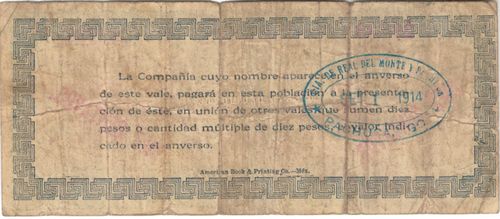La Compañía de Real del Monte y Pachuca
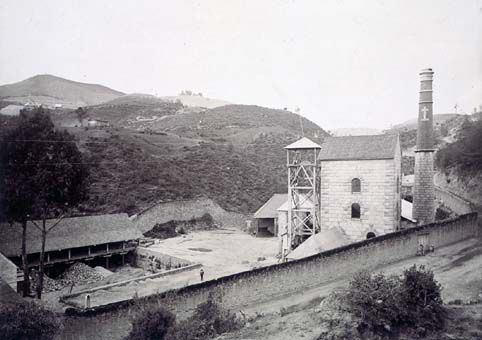
Situated at over 8,000 feet above sea level in the once densely wooded mountains of the state of Hidalgo, the city of Pachuca, some fifty miles east of Mexico City, lies at the head of a ravine within a semi-circle of bare brown hills. Real del Monte (also known as Mineral del Monte) lies over the mountains four miles to the north east of Pachuca, and is rather more wooded and green.
The silver-mining Compañía de Real del Monte y Pachuca was established in 1848, with Mexican and North American capital, but in February 1906, along with other local mines, was acquired by the United States Smelting Refining and Mining Company.
During the revolution, because of the difficulties in communications and subsequent shortage of currency, this company was one of several in the state that issued its own currency. The scrip was used to meet payrolls and used as local legal tender in Pachuca and its vicinities.
1914 issue
The local management of the Compañía Minera de Real del Monte y Pachuca sent a “Weekly Gossip Letter” to their Boston head office, and these provide a detailed background to their issues. The company struggled as long as they could to get coins and banknotes from Mexico City to make their payroll, but finally had to resort to producing their own paper.
On 29 December 1913 Charles W. Van Law reported that currency had almost disappeared from circulation. Only Banco Nacional de México and Banco de Londres y México notes circulated and metallic currency, through actual melting down or hoarding, had been effectively retired. Approximately 200,000 pesos was required for the weekly pay day but when paid out this money was hoarded by businesses or snapped up by agents from Mexico City. The company had itself been secretly laying aside currency and had other contingency plans to make its payrollAMinería, Fondo Norteamericano, vol. 41, exp. 15, Dirección General, Correspondencia, Mar 1913 – Nov 1914 Weekly Gossip letter 29 December 1913. By 12 January 1914 D. S. Callard could report that matters had somewhat improved AMinería, Fondo Norteamericano, vol. 41, exp. 15, Dirección General, Correspondencia, Mar 1913 – Nov 1914 Weekly Gossip letter 12 January 1914 but by 26 January Mexican money in denominations of less than five pesos has almost entirely disappeared from circulation and the company was barely able to obtain enough change for the Saturday payroll.
On Saturday, 24 January 1914, some of the principal merchants of Pachuca called upon the mining companies and asked them to issue script as had been done elsewhere. They explained that their sales had been cut very heavily through lack of change and that they would not only welcome mining companies’ paper but would help in any way the companies could suggest. As all the mining companies had been experiencing great difficulties in obtaining change for payrolls, a meeting was held in the Compañía de Real del Monte y Pachuca's office which was attended by representatives of the eight principal companies who discussed the entire situation at length. In the afternoon, by special appointment, the same group met at the office of the Governor of the state to ask his aid in this matter. It was explained to the Governor that as issuing vales was against federal law, they could not see their way clear to proceed upon a purely verbal arrangement. The Governor agreed and dictated a telegram to the Federal Government giving complete details of the plans. He received an answer approving the issue but insisting upon bank deposits to cover the value of issues. The mining companies objected to this on the grounds that since the banks were not forced to make any payment until 31 March the companies would have to carry a deposit in their own vault as well as in the bank to cover the issues. A second telegram from the Governor obtained permission to proceed up to any amount and in any manner desired and without the necessity of making a deposit of any kindAHMM, Fondo Norteamericano, Sección Compañías Filiales y/o Subsidiarias 1842-1987, La Unión correspondencia 6 Jan 1913 – 24 May 1914, vol. 196, exp. 65. The Governor gave the mining companies certified copies of these telegrams, together with a signed statement absolving them from all subsequent proceedings.
In a later meeting the eight companies decided to issue a uniform type of vale with the names of the different companies appearing on vales corresponding to the amount of their proportion of the first issueIn the end only five companies used the common format. It was also decided that great care should be taken and considerable expense incurred to prevent the possibility of falsification. It was to be stated upon the face of the vales that they would be redeemed in amounts of $10 or multiples of $10 (in fact it was stated on the reverse: on the face it was stated that the notes were backed by an equivalent sum held in the company’s vaults (que ha sido entregada en la Caja de esta Compañía))AHMM, Fondo Norteamericano, vol. 41, exp. 15, Dirección General, Correspondencia, Mar 1913 – Nov 1914 weekly gossip letter 26 January 1914.
The Compañía de Real del Monte y Pachuca subscribed for $50,000 in vales, the amount they expected to need for four weeks.
These notes were printed by the American Book and Printing Company, of Mexico City. The company had had little experience with this type of work and was under time pressure, working twenty-four hours a day to complete the orders, and the result was disappointing. The vales were received from the printers on the Saturday evening, 7 February, too late for the weekly raya. The Compañia Real del Monte y Pachuca was so dismayed by their poor qualityAHMM, Fondo Norteamericano, vol. 41, exp. 15, Dirección General, Correspondencia, Mar 1913 – Nov 1914 weekly gossip letter 10 February 1914 that they only began to use them a few weeks later out of sheer necessity.
Others companies did use the notes and the first day they went into circulation the local Oficina de Timbre served notice that they would be fined 40 centavos for each vale issued, irrespective of its denomination, in conformity with the stamp law which stated that all cheques of denominations less than $100 had to carry stamps of four centavos, with a fine ten times that amount. They also started to cause a great lack of confidence by announcing that holders of the notes would be prosecuted. The matter was immediately taken up with Governor Agustín Sangines who wired immediately to headquarters in Mexico City, following which the local stamp office was promptly wired to keep out of any controversy with mining companies over vales issued without stamps; that they had been proceeding exactly according to instructions received from the Government and were not to be molested in any wayAHMM, Fondo Norteamericano, vol. 41, exp. 15, Dirección General, Correspondencia, Mar 1913 – Nov 1914 weekly gossip letter 17 February 1914.
The Real del Monte notes were reported to have been in use by 12 FebruaryEl País, Año X, Núm. 4536, 12 February 1914 but in fact were not used until Saturday, 21 February when $10,000 was paid to workers. The launch was only fairly successful but it was hoped that the difficulties would disappear within a couple of weeks. The vales were accepted without question by the banks, street railways and regular business houses but the smaller vegetable vendors in the plaza refused to accept them. Part of the shift at Rosario refused to go in Sunday morning because of this but returned to work Monday. It was expected that one or two of the smaller merchants who were refusing vales would soon realize that they could increase their sales to a very large extent by accepting vales when they were refused by their competitors, but in case this did not happen, one of the principal grocery stores in the town decided to set up a vegetable stand in the plaza, announcing with a large sign over its place of business that vales only would be receivedAHMM, Fondo Norteamericano, vol. 41, exp. 15, Dirección General, Correspondencia, Mar 1913 – Nov 1914 weekly gossip letter 24 February 1914. By late March practically all local business was done with mining company vales which were readily acceptedAHMM, Fondo Norteamericano, vol. 41, exp. 15, Dirección General, Correspondencia, Mar 1913 – Nov 1914 weekly gossip letter 23 March 1914.
There were two types of Compañia Real del Monte y Pachuca notes. The first (values from 5c to $1) had the company’s name at the top.
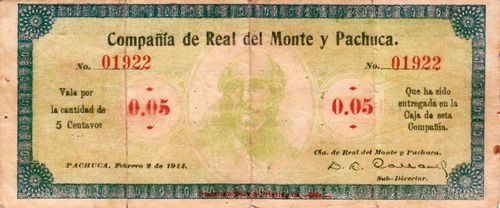
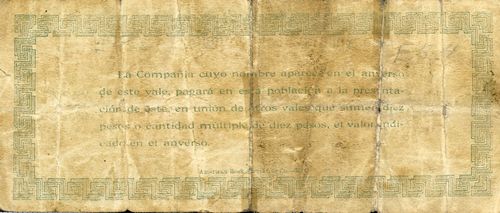
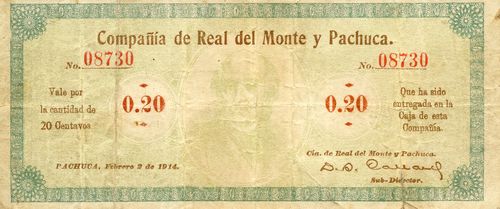

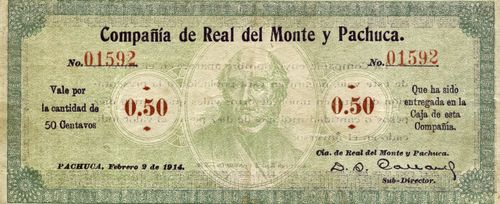
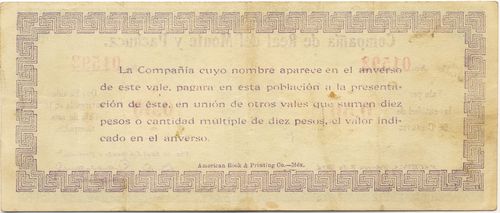


| Date of issue | Date on note | from | to | total number |
total value |
||
| 5c | after 21 February 1914 | 2 February 1914 | includes numbers 00245CNBanxico #11223 to 07771 | ||||
| 10c | |||||||
| 20c | includes number 08730 | ||||||
| 50c | $43,071.50 | includes number 01392 | |||||
| $1 | includes numbers 16774 to 18248CNBanxico #11226 | ||||||
The notes that the American Book and Printing Company produced for the other concerns are all of this type.
Originally these notes were well received. After three weeks practically none had been returned for redemption by the mining companies, but neither was a great amount of this paper in circulation; practically all vales issued had simply disappeared. In locations where $15,000 per week had been paid out to employees in company paper, silver and banknotes had become more numerous and the script was being hoardedAHMM, Fondo Norteamericano, vol. 41, exp. 15, Dirección General, Correspondencia, Mar 1913 – Nov 1914.
On 15 June Genaro C. García wrote to D. S. Calland, then in Boston, to say that they had found it necessary to have a new supply of 5c, 10c and 20c vales ($4,300 in all) printed that week to begin replacing old vales of these denominations which were no longer fit for circulation on account of use. The new issue would have printed in large red letters the value of each denomination in order to avoid alteration which was very easy on the old valesAHMM, Fondo Norteamericano, vol. 41, exp. 15, Dirección General, Correspondencia, Mar 1913 – Nov 1914. García added that if present conditions should continue for any length of time, he felt it would be a good idea to have the vales which Calland intended to order from the American Bank Note Company printed and sent to them. This new issue had the serial numbers twice at the top of the note.
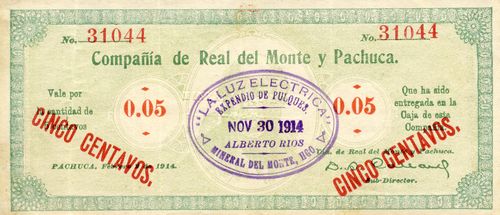
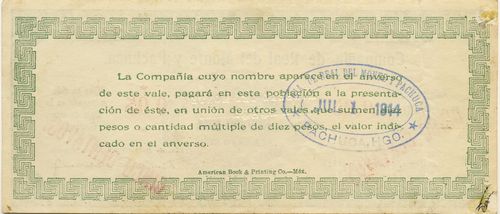
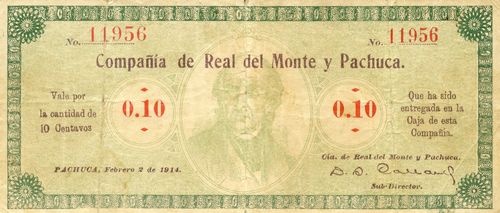
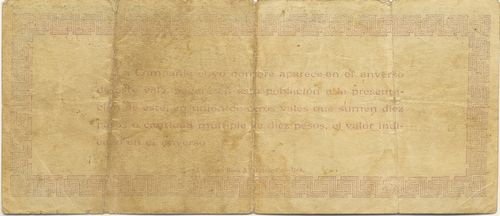
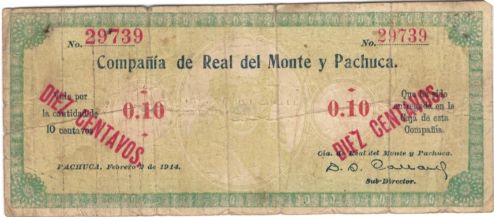
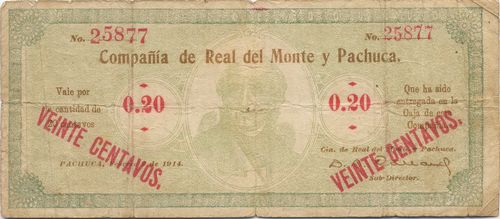
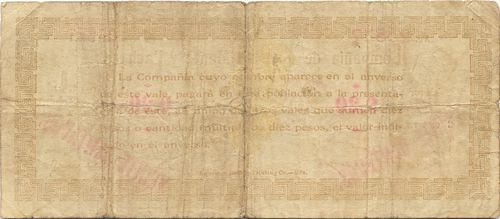
| Date of issue | Date on note | from | to | total number |
total value |
||
| 5c | after 15 June 1914 | 2 February 1914 | includes numbers 27277CNBanxico #11224 to 47293 | ||||
| 10c | without DIEZ CENTAVOS includes number 11956 |
||||||
| with DIEZ CENTAVOS includes number 29739CNBanxico #11225 |
|||||||
| 20c | includes number 25877 | ||||||
| $4,300 |
Both these issues have the printed signature of D. S. Callard as Sub-Director.
| D. S. Callard |  |
On 15 June it was reported that crude counterfeits of the 50c and $1 Santa Gertrudis notes were circulating so the company, like all the others, decided to withdraw its own 50c and $1 notes and posted notices[text neded] to that effect. By agreement with the other companies, the 5c, 10c and 20c vales were to continue in circulation until further notice, but as the plates for all the vales were the same, it was felt that the counterfeiters will soon move onto the smaller denominations and the companies would eventually have to retire their entire present issueAHMM, Fondo Norteamericano, vol. 41, exp. 15, Dirección General, Correspondencia, Mar 1913 – Nov 1914 letter G. C. García to D. S. Calland, Boston, 1 July 1914. The company had $43,071.50 in 50c and $1 vales in circulation and almost all were redeemedAHMM, Fondo Norteamericano, vol. 41, exp. 15, Dirección General, Correspondencia, Mar 1913 – Nov 1914 letter G. C. García to D. S. Calland, Boston, 10 July 1914.
In late October the company began to withdrawn all the vales from circulation, as the majority of them were in very bad condition and the company expected to be able to get a sufficient supply of fractional currency in Mexico City. All the other companies issuing vales did the sameAHMM, Fondo Norteamericano, vol. 41, exp. 15, Dirección General, Correspondencia, Mar 1913 – Nov 1914 letter G. C. García to D. S. Calland, Mexico City, 20 October 1914.
Abortive American Bank Note Company issue
As stated, the quality of these locally printed notes did not impress the company’s directors. When the American Bank Note Company’s resident agent in Mexico, Charles T. Blackmore, heard that they were dissatisfied, he visited Pachuca and tried to interest them in getting their notes printed by the ABNC. D. S. Callard mentioned the expectation of ABNC vales in his weekly gossip letter of 3 MarchAHMM, Fondo Norteamericano, vol. 41, exp. 15, Dirección General, Correspondencia, Mar 1913 – Nov 1914 weekly gossip letter 3 March 1914 and following correspondence in late March and early April the ABNC quoted for an issue of 300,000 pieces in five denominations (120,000 5c, 70,000 10c, 30,000 20c ,40,000 50c and 40,000 $1). The notes were to have a mining vignette on the face and a vignette of the coin of the denomination each vale represented on the back, and have the typed signatures of M. A. Doak as auditor and D. S. Calland as sub-director.
By 14 April Blackmore was confident enough to telegraph New York to “commence at once printing lithographed backs fractional currency vales for Real del Monte. You will be advised later regarding face. Are in great need of.” and he followed this with a letter asking them to pay particular attention to the work as several other mining companies were waiting to see the result of the order. The ABNC therefore started work on the models, but on 23 April were told to stop, on 4 May told to start again, but then on 11 May the New York office of the Compañía de Real del Monte y Pachuca wrote to the ABNC asking them to suspend work. By that time the ABNC had practically completed all the designs.
On 28 May Blackmore wrote explaining that all the foreign employees of the company had left their work and the mines etc. were being run by one of the Mexican directors. The two gentlemen Blackmore had been negotiating the printing contract with had left for Veracruz. On 3 July someone from the New York office of the Compañía did telephone the ABNC to ask how much work had been done and was told that it would take about a week to complete the models and that they could begin shipping in about ten weeks, but nothing came of thisABNC.
1915 issues
In early 1915 the company, along with other companies in the area, again issued scrip. On 13 February the newly-arrived Carranzista governor Fortunato Maycotte, on his first day in office, invalidated the Villista sábanas and dos caritas issues, and, in order to ease business transactions, conceded permission to the mining companies to issue bearer cheques, fully guaranteed by the same companiesPeriódico Oficial, Hidalgo, Tomo XLVIII, Núm. 13, 16 February 1915. In a few days he was to set up offices to exchange the said notes, so it seems that these 1915 issues were a direct consequence of the disappearance of Villista currency. We have records of official authorization for other issuesMaycotte’s authorization to the Negociación Minera San Rafael y Anexas on 20 February and to the Negociación Minera Hacienda Grande Purísima y Minas Guadalupe Fresnillo y Anexas three days later, or Teniente Coronel José L. Aguilar’s authorization to the Compañía de Santa Gertrudis on 2 March but no mention of any official authorization for the Compañía de Real del Monte y Pachuca seems to have survived.
This time, in accordance with the decree, the Compañía’s scrip was in the form of cheques drawn on its account at the Bank of Montreal.
There were two distinct issues. One extremely rare group of three denominations ($5 – Series L; $10 – Series N; and $20 – Series M) was printed by Tipografía Artística, bear the rubber-stamped date 28 May 1915 and the hand signatures of D. S. Callard as director and M. A. Doak as auditor.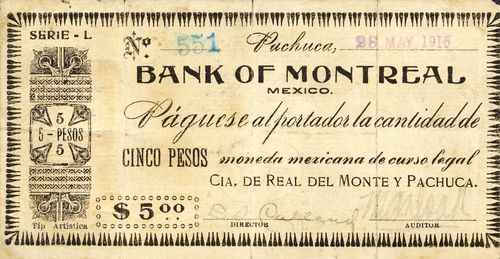
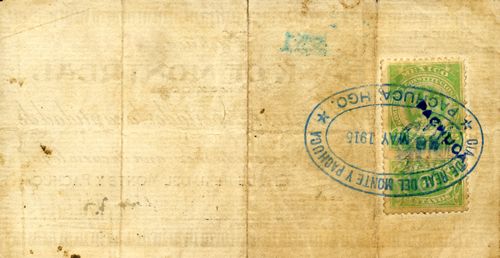
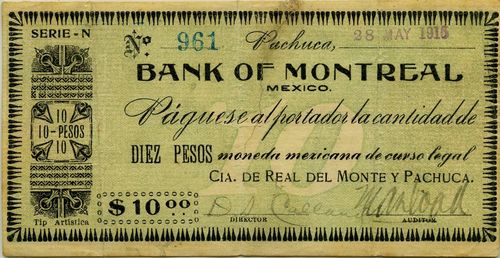
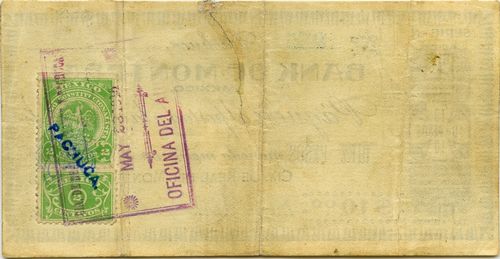
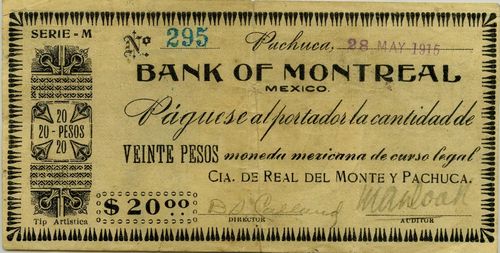
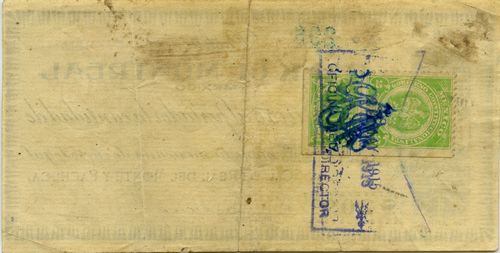
| Series | from | to | total number |
total value |
||
| $5 | L | includes numbers 152CNBanxico #11239 to 551 | ||||
| $10 | N | includes number 961 | ||||
| $20 | M | includes numbers 252 to 295 | ||||
As stated, these issues have the signature of D. S. Callard, now as Director, and M. A. Doak as Auditor.
| D. S. Callard | |
| M. A. Doak |  |
Bouligny & Schmidt cheques
The other issue was for a sequence of five values, printed by the Mexico City firm of Bouligny & Schmidt and bearing various rubber-stamped dates from April to June 1915. On 19 February D. S. Calland reported that it had proved necessary to issue bearer cheques, lithographed by Bouligny & Schmidt, for 1, 5, 10 and 20 pesosAHMM, Fondo Norteamericano, vol. 9, exp. 13, Dirección General, Correspondencia, Dic 1914 – Feb 1917 weekly gossip letter 19 February 1915 and on 26 February Bouligny & Schmidt completed its order of 81,000 valesAHMM, Fondo Norteamericano, vol. 8, exp. 11, D. S. Callard General Correspondence August 1914 – July 1915.
The fifth denomination, for $2,50, was obviously added later, as its serial letter, E, proves.
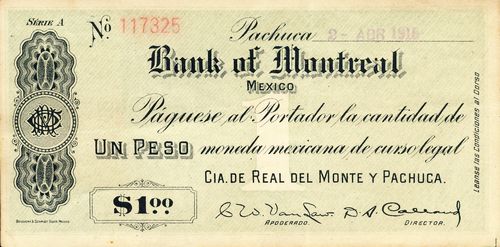
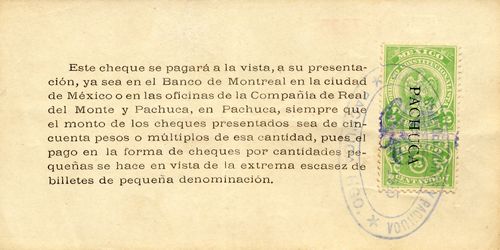
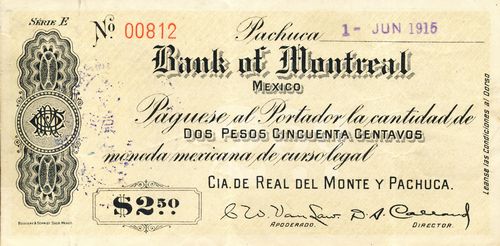
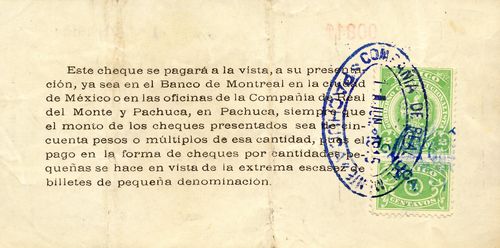
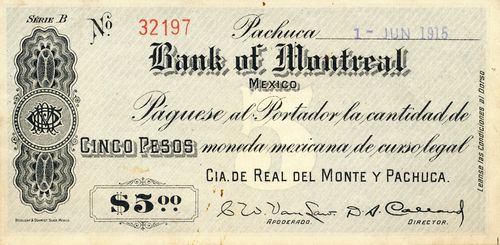
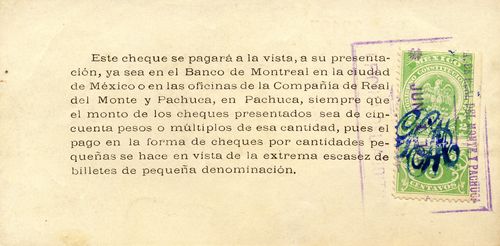

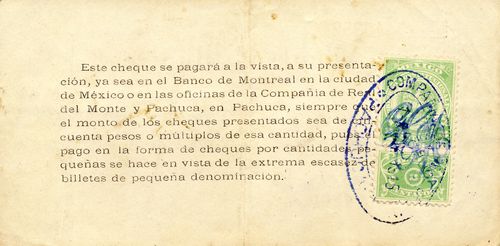
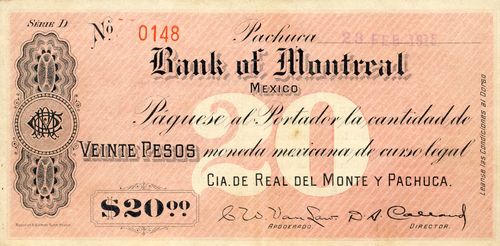
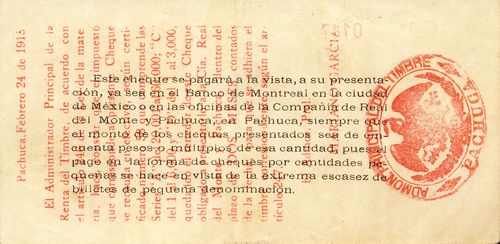
These issues have the printed signatures of C. W. Van Law as attorney (apoderado) and D. S. Callard as Director.
|
Charles (Carlos) Whitney Van Law, was born in 1874, and in 1882 he moved from Marietta, Ohio, his native town, to Colorado, the cradle of so many clever and successful mining men. He was prepared for college in the Chicago Manual Training School, then went to Cornell University, graduating in mechanical engineering in 1896, with special honours for original research. Immediately upon graduation, he went to the Tomboy mine, Telluride, Colorado, there acting as assistant to the superintendent of mills. In 1898 he became successively Master Mechanic and Mill Superintendent of the Columbia Menona Company, in the same district. Then he spent six months in Sonora for the Sonora Development Company, being in charge of their ten mining enterprises. In 1889 he returned to Georgetown, Colorado, as manager of a silver-lead proposition located there. In the same year, he was engaged by the intending purchasers of the Smuggler Union Property, in Telluride, Colorado, to make a series of metallurgical tests upon the existing plant, which was brought to a 500-tons-a-day capacity as the results of these same experiments. In 1902 Van Law became associated with the machinery manufacturing firm, the Allis-Chalmers Company, in Chicago, and in August 1903, he was appointed as the Chief Engineer of their Mining Department, a position which he occupied until he was engaged to make an examination of the various properties of the Guanajuato Reduction and Mines Company, and ended by becoming their Resident Manager in September 1904The Mexican Herald, 2 September 1904. He became manager of the Real del Monte in December 1909The Mexican Herald, 5 December 1912, the third manager since the company had been acquired in 1906 by the Boston based United States Smelting and Refining Company. |
 |
| D. S. Callard |
On the reverse it stated that these could be redeemed at the company’s office or at the Mexico City branch of the Bank of Montreal, in multiples of fifty pesos.
Some of these have cancelled revenue stamps on the reverse whilst others have an overprinted text from the Administrador Principal de Rentas, Mariano Garcia (either in black, dated 18 February 1915 or in red, dated 24 February) that explains the lack of a stamp, in words which translate as “The Administrador Principal de la Renta del Timbre, in accordance with article 246 of the relevant legislation, notes that the tax on this particular cheque has been paid in cash, according to certificate no. … and the holder is obliged to present it at the Company’s offices within two months for the revenue stamp to be affixed”. The article in question is that of the general legalisation on stamp duty (Ley de la Renta Federal del timbre) of 1 June 1906, which make provision in the event of a lack of revenue stampsArt. 246. Si en algún lugar faltaren estampillas, el que necesite timbrar un documento ó libro lo presentará á la oficina del Timbre para que lo legalice, previo el pago del impuesto de las estampillas que debieran usarse, y poniendo una nota de legalización que autorizará el jefe de la oficina, quien expedirá al interesado una certificación de haber hecho el pago en efectivo por falta de estampillas.
From these and the notes themselves we can reconstruct the following table:
| Series | Date on note | from | to | total number |
total value |
|||
| $1.00 | A | 18 February 1915 | 1 | 20000 | 20,000 | $ 20,000 | Covered by certificate no. 57 | |
| 24 February 1915 | 20001 | 60000 | 40,000 | 40,000 | Covered by certificate no. 58 | |||
| 10 March 1915 | 60001 | with revenue stamps | includes number 70408CNBanxico #11240 | |||||
| 18 March 1915 | includes number 74917 | |||||||
| 25 March 1915 | ||||||||
| 2 April 1915 | includes number 136363 | |||||||
| 7 April 1915 | ||||||||
| 19 April 1915 | ||||||||
| 23 April 1915 | includes number 160432 | |||||||
| 1 June 1915 | ||||||||
| $2.50 | E | 16 May 1915 | includes number 7103CNBanxico #11241 | |||||
| 1 June 1915 | with revenue stamps | includes number 00206 | ||||||
| $5.00 | B | 1 | 2000 | 2,000 | 10,000 | Covered by certificate no. 57 | ||
| 18 February 1915 | includes numbers 3102CNBanxico #11242 to 10236 | |||||||
| 23 April 1915 | with revenue stamps | |||||||
| 1 May 1915 | ||||||||
| 1 June 1915 | includes numbers 30505 to 32251 | |||||||
| $10.00 | C | 24 February 1915 | 1 | 6000 | 6,000 | 60,000 | Covered by certificate no. 58 | includes number 2498CNBanxico #11244 |
| 23 April 1915 | 6001 | with revenue stamps | ||||||
| 1 May 1915 | ||||||||
| 1 June 1915 | includes number 14444 | |||||||
| $20.00 | D | 23 February 1915 | 1 | 3000 | 3,000 | 60,000 | Covered by certificate no. 58 | |
| 7 April 1915 | 3001 | with revenue stamps | includes number 3189 | |||||
| 27 April 1915 | includes number 2651 | |||||||
| 1 June 1915 | includes numbers 6243 to 6697CNBanxico #11245 |
The $5 and $20 cheques were counterfeited. On 28 April the company wrote to Guillermo Brockmann and other banks the same letter was sent to Guillermo. Brockmann, the Banco Nacional de México, the Banco de Londres y México, the Banco Germánico de la América del Sur, the Canadian Bank of Commerce, the Banco Internacional é Hipotecario, the Banco Mexicano de Comercio é Industria, the Mercantile Banking Co. and the Mexico City Banking Co. that these two denominations had been falsified and requested them not to accept any of these cheques either for deposit or in payment of accounts, but to refer them all to the Bank of Montreal for checkingAHMM, Fondo Norteamericano, vol. 8, exp. 11, D. S. Callard General Correspondence August 1914 – July 1915.
Note that these are relatively high values (and redeemable in the sizeable amount of fifty pesos) so would have been aimed at a different clientele to the previous issue of low value notes. However, there was still a need for the latter. On 29 March 1915 the Secretaría de Hacienda y Crédito Público authorized the then governor, General Alfredo J. Machuca, in turn to authorize local businesses to issue up to $500,000 in vales of 5c, 10c, 20c and 50c, having previously deposited a similar amount in the Tesorería General as surety. However, the government preferred to make its own issue, in accordance with a decree of 29 April. It issued 20c, 25c and 50c notes, and then, during July, when Villistas controlled the town, they took $3,000 in 10c vales from the government printers to pay their own troops.
Withdrawal
On 12 August 1915 the Carranzista administration in Veracruz asked the government in Hidalgo for a report on the private issues. In his August report to the Secretaría de Gobernación, Arturo Lazo de la Vega records that the “Blanca y Anexas”, “Maravillas y San Francisco”, “Real del Monte y Pachuca” and “San Diego”, had issued cheques for $1, $5, $10, $20 and $50 but does not know the amounts issuedAGN, Fondo Gobernación Periodo Revolucionario, caja 93, exp. 36, folletos 8 Secretario general L. de la Vega to [ ], Pachuca, 20 August 1915. In response, on 9 September the Secretaría de Gobernación replied that all these issues should be withdrawnAGN, Fondo Gobernación Periodo Revolucionario, caja 93, exp. 36, folletos 8. On 20 December Lazo de la Vega, said that the government had prohibited the cheques and would exchange them in the Tesorería General del Estado until 28 February 1916, after which they would lose any value. Anyone circulating the cheques would be finedPeriódico Oficial, Hidalgo, Tomo LXIX, Núm. 1, 1 January 1916. On the same day Francisco Palacios, the Director General de Rentas, gave companies that had issued cheques and vales five day to deposit their value in legal tender in the Tesorería General del Estado, so that the Tesorería could exchange the notesPeriódico Oficial, Hidalgo, Tomo LXIX, Núm. 1, 1 January 1916.
However, these vales continued to circulate. On 25 January 1916 it was reported that the government had issued another decree[text needed] forbidding them, fixing up copies of the order throughout the city. The decree warned of exemplary penalties for infractions since the government was determined to end their circulation at any cost. Since then businesses and individuals had stopped accepting them and the mining companies had begun to redeem themEl Demócrata, 26 January 1916.
A request was made for the period for redemption to be extended until 31 March. Also, the combined mining companies asked Luis Cabrera, the Secretario de Hacienda, for some decision concerning cheques presented outside of the state of Hidalgo, after 28 February, in order that the companies were not obliged to redeem the cheques twiceAHMM, Fondo Norteamericano, vol. 9, exp. 13, Dirección General, Correspondencia, Dic 1914 – Feb 1917 letter D. S. Callard 21 February 1916. In the meantime the company arranged with the local State Government to make a cut-off at the end of business on 28 February, returning to them all the redeemed cheques which they would combine with those in their possession, procure witnesses and a Notary Public and burn the whole amountAHMM, Fondo Norteamericano, vol. 9, exp. 13, Dirección General, Correspondencia, Dic 1914 – Feb 1917 letter D. S. Callard 28 February 1916. The extension until 31 March was granted but Cabrera’s decision delayed, leading to speculators buying the cheques at a small premium and sending them to Mexico City. It was estimated that probably at least 50% of the outstanding vales were in the hands of speculatorsAHMM, Fondo Norteamericano, vol. 9, exp. 13, Dirección General, Correspondencia, Dic 1914 – Feb 1917 letter D. S. Callard 6 March 1916.
During the first months of 1916 D. S. Callard recorded the company’s outstanding liabilityAHMM, Fondo Norteamericano, vol. 9, exp. 13, Dirección General, Correspondencia, Dic 1914 – Feb 1917:
| Bank of Montreal cheques | Bank of Hidalgo cheques | Vales cheques | Total | Less “good paper” (cheques of other companies) | Current liability | |
| 7 February | 469,682.74 | 50,685.40 | 253,364.95 | 773,733.09 | 69,773.04 | 703,960.05 |
| 14 February | 293,367.94 | 47,950.30 | 189,273.95 | 530,592.19 | 85,826.06 | 444,766.13 |
| 21 February | 278,478.24 | 47,836.51 | 166,311.00 | 492,625.75 | 85,826.06 | 406,799.69 |
| 28 February | 266,878.24 | 46,701.51 | 118,271.00 | 431,850.75 | 85,550.21 | 346,300.54 |
| 6 March | 258,404.74 | 46,371.07 | 107,974.00 | 412,749.81 | 88,105.81 | 324,644.00 |
| 13 March | 258,404.74 | 46,371.07 | 107,974.00 | 412,749.81 | 88,105.81 | 324,644.00 |
| 27 March | 255,354.74 | 41,273.30 | 99,405.50 | 396,033.54 | 88,105.81 | 307,927.73 |
| 10 April | 255,354.74 | 41,273.30 | 99,405.50 | 396,033.54 | 88,105.81 | 307,927.73 |
| 17 April | 305,427.73 |
On 30 June 1916 P. E. Phillips took the vales deposited in their vaults up to Loreto and had them destroyed by fireAHMM, Fondo Norteamericano, vol. 9, exp. 13, Dirección General, Correspondencia, Dic 1914 – Feb 1917 letter P. E.Phillips to D. S. Callard, Veracruz 30 June 1916.

